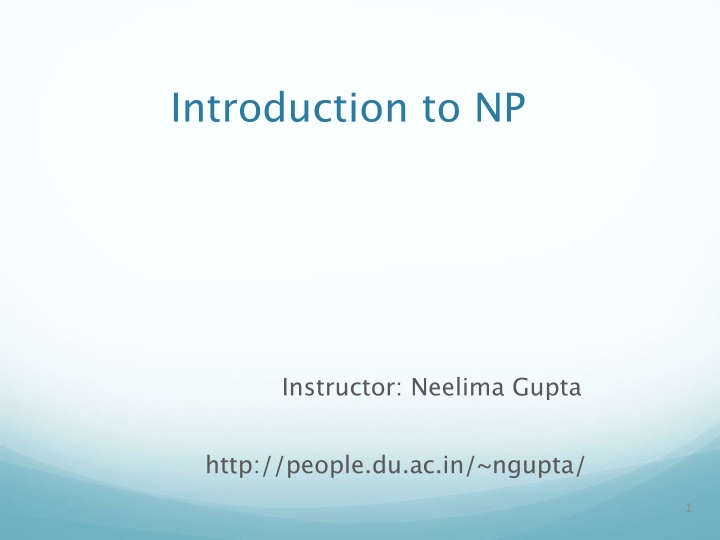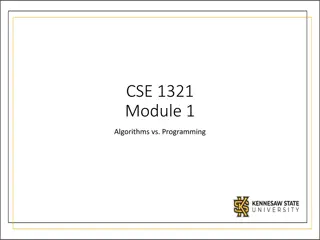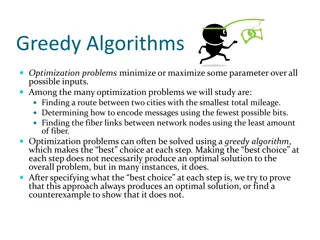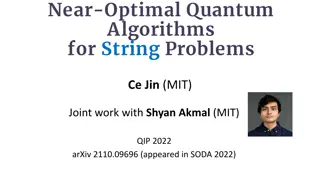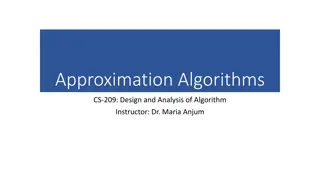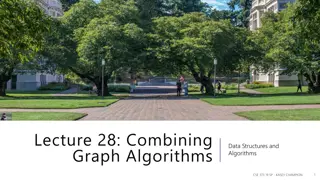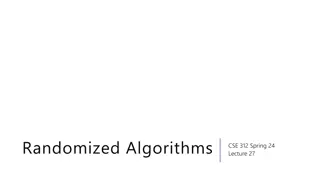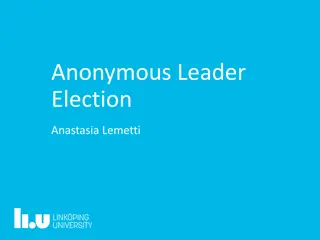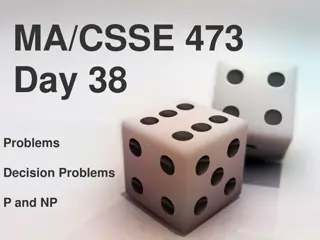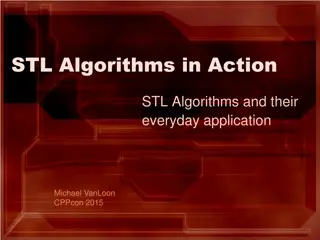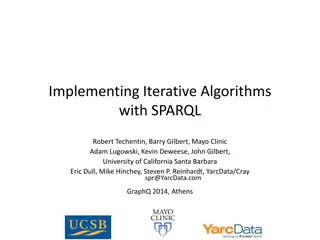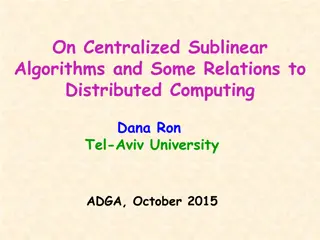NP Problems and Decision Algorithms
Delve into the realm of NP problems and decision algorithms with a focus on optimization, decision versions of problems, the NP class, and verification algorithms. Explore complexities, solutions, and the significance of verification in solving computational challenges.
Uploaded on Sep 19, 2024 | 0 Views
Download Presentation

Please find below an Image/Link to download the presentation.
The content on the website is provided AS IS for your information and personal use only. It may not be sold, licensed, or shared on other websites without obtaining consent from the author.If you encounter any issues during the download, it is possible that the publisher has removed the file from their server.
You are allowed to download the files provided on this website for personal or commercial use, subject to the condition that they are used lawfully. All files are the property of their respective owners.
The content on the website is provided AS IS for your information and personal use only. It may not be sold, licensed, or shared on other websites without obtaining consent from the author.
E N D
Presentation Transcript
Introduction to NP Instructor: Neelima Gupta http://people.du.ac.in/~ngupta/ 1
Table of Contents Problems to be discussed Clique Vertex Cover Hamiltonian Cycle Independent Set Set Cover Subset Sum
Optimization Problems we have seen Weighted Interval Scheduling Matrix Chain Multiplication Segmented Least Squares Knapsack Sequence Alignment Shortest Path - Solvable in Polynomial Time by Dynamic Programming or Greedy Approach except 0-1 Knapsack which is Pseudo- polynomial.
Optimization Vs Decision Problems In case of Optimization problems, each feasible solution has an associated value, and we want the feasible solution with the best value. Eg: Shortest path problem Given an undirected graph (G,s,t), we want to compute the shortest path from vertex s to vertex t (path using fewest edges).
Optimization & Decision Problems In case of Decision problems, the answer to the problem is a simple yes or a no (more formally, 1 or 0). We can obtain a related decision problem for a given optimization problem by bounding the value to be optimized. Eg: Shortest path problem (Decision Version 1) Given an undirected graph (G,s,t,k), is there a path from vertex s to vertex t consisting of exactly k edges? Shortest path problem (decision version 2) Given an undirected graph (G,s,t,k), is there a path from vertex s to vertex t consisting of at most k edges?
Exercise 1 Give the decision versions (of type 2) for the following problems : i. ii. iii. Optimal Binary Search Tree iv. Activity Selection Problem v. Minimum Spanning Tree Longest Common Subsequence Matrix Chain Multiplication
Class NP The class of decision problems for which there is a polynomially bounded nondeterministic algorithm. Or Equivalently The class of decision problems which can be verified in polynomial time.
Verification A Verification algorithm takes as an input, a problem instance, and a certificate and decides whether it is a yes-instance. A(x,y) = 1; iff, y is a valid certificate. input certificate instance
Verification: Shortest Path Example Let L1- SP = {<G,s,t,k>: a path from s to t Let x SP, then we claim that a certificate y such that, <G,s,t,k,y> can be verified in polynomial time. of length = k} What is that? Ans: Since x SP, a path (sequence of vertices) from s to t of length = k. This path itself serves as the certificate y. What does the verification algorithm do? Ans: Just check that the given sequence of vertices in y indeed forms a path in G (i.e. check that between every consecutive pair of vertices there is an edge in G) and, That its length is k.
Verification Running Time Adjacency Matrix Representation of Graphs: Checking an edge takes constant time. Linked List representation of Graphs: To check an edge, we can scan the adjacency list of one of its end points. Since length of the adjacency list is O(V), it can be checked in O(V) time. In either case checking an edge takes O(V) time. How many checks? Ans: O(V) Thus the total time is O(V2) time. Hence, we can verify the certificate in polynomial time.
More NP Problems Clique Vertex Cover Hamiltonian Cycle Independent Set Set Cover Subset Sum
Definition: Clique Given an undirected graph G =(V,E), a clique is a subset V of V such that every pair of vertices in V is connected by an edge in E. In the graph to the right, vertices {1,2,5} form a clique since there is an edge between every pair of edges of this set.
G Green ovals represent CLIQUE for this graph
Clique Problem OPTimization Problem : Given an undirected graph G find a largest Clique in G. Decision problem: Given G, does there exist a clique of size equal to k in G? Clique = {(G,k): G contains a clique of size k}
Clique is in NP Clique = {<G,k>: G has a clique of size k} For x = <G,k> in Clique, does there exist a certificate y: |y| = polynomial in the length of x and a polynomial time algorithm that can use y to verify that x is in Clique? Show the existence of y, Show that |y| = polynomial in the length of |x|, Give an algorithm that verifies x using y, Show that the algorithm runs in polynomial time in |y| and |x| and hence in polynomial time in the length of |x|. SO, FOUR STEPS TO SHOW THAT A PROBLEM IS IN NP
Verification Let x (=(G,k)) Clique, then we claim that a certificate y such that, <x,y> i.e. <G,k,y> can be verified in polynomial time. Since x Clique, a clique of size k in G (by the definition of the set). This set of vertices itself serves as the certificate y. Clearly |y| is no more than the number of vertices in G. i.e. |y| = O(|x|) What does the verification algorithm do? Ans: Just check that the given set of vertices in y indeed forms a clique in G and, That its size is k.
Verification Algorithm Algo: For every pair of vertices u and v in y, check that there exists an edge (u,v) in G Running Time: : kC2 * degree(u) =kC2.O(V) = O(k2).O(V) =O(V2.V) =O(V3) Checking the |y| is k takes constant time. Hence, we can verify the certificate in polynomial time.
Vertex Cover A vertex cover of an undirected graph G = (V,E) is a subset V of V, such that if an edge (u,v) E, then at least one of u and v is in V .
with V` = {1,2,3,4} edges covered are, with V` = {1,2,3,4,6} edges covered are, Minimal set V` to cover all edges is {2,3,6,8}, 1 2 3 4 5 6 7 8
Vertex Cover Problem OPTimization Problem : Given an undirected graph G find a smallest vertex cover in G. VC(G,k) : Given G, does there exist a vertex cover of size equal to k in G? VC = {(G,k): G contains a vertex cover of size k}
Vertex Cover is in NP VC = {<G,k>: G has a vertex cover of size k} For x = <G,k> inVC, does there exist a certificate y: |y| = polynomial in the length of x and a polynomial time algorithm that can use y to verify that x is in VC? Show the existence of y, Show that |y| = polynomial in the length of |x|, Give an algorithm that verifies x using y, Show that the algorithm runs in polynomial time in |y| and |x| and hence in polynomial time in the length of |x|. SO, FOUR STEPS TO SHOW THAT A PROBLEM IS IN NP
Verification Let x (=(G,k)) VC, then we claim that a certificate y such that, <x,y> i.e. <G,k,y> can be verified in polynomial time. Since x VC, a vertex cover of size k in G (by the definition of the set). This set of vertices itself serves as the certificate y. Clearly |y| is no more than the number of vertices in G. i.e. |y| = O(|x|) What does the verification algorithm do? Ans: Just check that the given set of vertices in y indeed forms a vertex cover in G and, That its size is k.
Verification Algorithm For every edge (u,v) in G check that at least one of the vertices u and v is in y. Running Time: |E| |y| =O(E V) Checking that |y| is k takes constant time. Hence, we can verify the certificate in polynomial time.
Hamiltonian Cycle A Hamiltonian cycle of an undirected graph, G, is a simple cycle that spans every vertex.
Forming an HC, 1 2 3 4 5
However, for the graph G`, there does not exist any Hamiltonian cycle. 1) with vertices 1,2,3,4 not an HC 2) with vertices 1,2,5,6,3 again not an HC 1 2 3 4 5 6
Hamiltonian Cycle Problem of HC is to find a HC in the given graph. Decision Version: Given an undirected graph G, does G contain a Hamiltonian cycle? HC = {(G) : G contains a Hamiltonian cycle}
HC is in NP HC = {<G>: G has a Hamiltonian cycle} For x = <G> in HC, does there exist a certificate y: |y| = polynomial in the length of x and a polynomial time algorithm that can use y to verify that x is in HC? Show the existence of y, Show that |y| = polynomial in the length of |x|, Give an algorithm that verifies x using y, Show that the algorithm runs in polynomial time in |y| and |x| and hence in polynomial time in the length of |x|. SO, FOUR STEPS TO SHOW THAT A PROBLEM IS IN NP
Verification Let x (=(G) HC, then we claim that a certificate y such that, <x,y> i.e. <G,y> can be verified in polynomial time. Since x HC, G contains a Hamiltonian cycle (by the definition of the set). This sequence of vertices that forms a HC in G itself serves as the certificate y. Clearly |y| is no more than the number of vertices in G. i.e. |y| = O(|x|) What does the verification algorithm do? Ans: Just check that the given sequence of vertices in y indeed forms a Hamiltonian cycle in G.
Verification Algorithm Let y = <u1, u2, um> Algo: For i =1 to m-1 check that (ui,ui+1) is an edge in G - check that (um,u1) is an edge in G - Check that no vertex is repeated. - Check that m = n (i.e. all the vertices have been spanned) Running Time: m |V| + m2 + constant =O(V2) Hence, we can verify the certificate in polynomial time.
Independent Set Given a graph G = (V,E), a subset S of V is said to be independent if no two nodes in S are joined by an edge in E.
Independent Set Problem OPTimization Problem : Given an undirected graph G find a largest independent set in G. Decision problem: Given G, does there exist an independent set of size equal to k in G? IS = {(G,k): G contains an independent set of size k}
IS is in NP (Exercise) IS = {<G,k>: G has an IS of size k} For x = <G,k> in IS, does there exist a certificate y: |y| = polynomial in the length of x and a polynomial time algorithm that can use y to verify that x is in IS? Show the existence of y, Show that |y| = polynomial in the length of |x|, Give an algorithm that verifies x using y, Show that the algorithm runs in polynomial time in |y| and |x| and hence in polynomial time in the length of |x|. SO, FOUR STEPS TO SHOW THAT A PROBLEM IS IN NP
Set Cover Problem Given a collection U of elements and a family S of subsets of U, a cover C is a sub-family of S ( i.e. a collection of subsets from S) whose union is U. Example: U = {1,2,3,4} S1 = {1,2}, S2 = {2,3}, S3 = {1,3,4}, S4 = {3,4}, S5 = {3}, S6 = {4} Then S1, S2, S3 is a cover of size 3; S1, S2, S6 is a cover of size 3; And S3, S1 is also a cover of size 2; We are interested in finding a cover of minimum size. Set Cover is in NP (Exercise)
Subset Sum Problem Given: A finite set S of integers and a target t I. To Find: If there exists a subset S of S whose elements sum up to t. Subset Sum is in NP (Exercise)
Acknowledgement Scribe by MSc (Computer Science) 2009. Prashant Singh ( NP Class) Sapna Grover ( P and NP , Vertex Cover, HC .) Soniya Verma (Independent Set) Shivam Sharma (Clique)
